In the mid-afternoon downtime, the taproom feels practically solemn. Down the steps from King Street in the brightly lit strip across from Roy Thomson, Mascot Brewing seems an odd fit for the neighbourhood. At least, it does until you realize that all the other tastes are catered for. 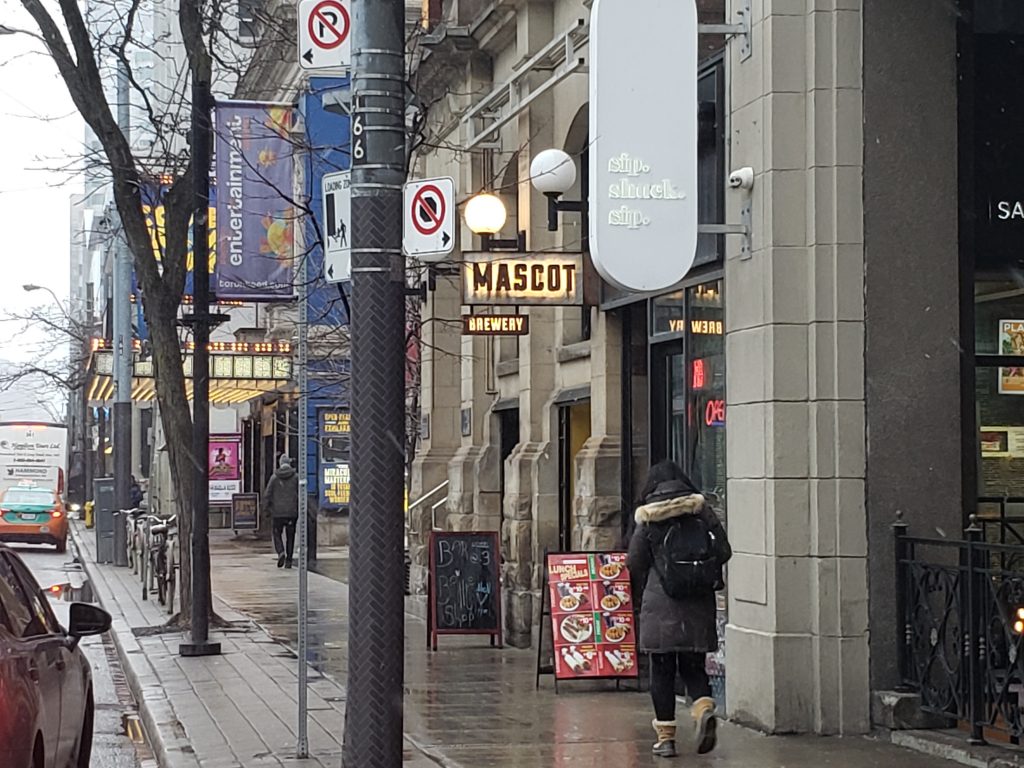 I keep having to explain to tourists that Toronto is fairly new to restaurants and at one time there were four right next to each other on this block, all owned by Ed Mirvish. They were all named after him too, with Ed’s Warehouse, Old Ed’s, Ed’s Chinese (I vividly remember the plum sauce), Ed’s Italian, and even Ed’s Folly. As time passed, we started getting more specialized fare in the theatre district: The Elephant & Castle. Barootes. Quotes (where Stephen Beaumont tended bar prior to writing for the Toronto Star.) The Acme Bar & Grill, I contend, would still play with a modern audience.
I keep having to explain to tourists that Toronto is fairly new to restaurants and at one time there were four right next to each other on this block, all owned by Ed Mirvish. They were all named after him too, with Ed’s Warehouse, Old Ed’s, Ed’s Chinese (I vividly remember the plum sauce), Ed’s Italian, and even Ed’s Folly. As time passed, we started getting more specialized fare in the theatre district: The Elephant & Castle. Barootes. Quotes (where Stephen Beaumont tended bar prior to writing for the Toronto Star.) The Acme Bar & Grill, I contend, would still play with a modern audience.
In an era of specialization, having a brewery tap in the theatre district is a sensible choice. When I walk in the room we’re hours from showtime and on a Wednesday at opening, the room is all but empty. The colour scheme seems odd to me with the light from the keg fridge cascading down the whitewashed cellar wall over empty tables and potted palms creating some palette reminiscent of 80’s Miami. It’s striking how different the space is conceptually from the previous iteration of Mascot on Mercer street.
Mascot is in the process of staffing up for the spring as I sit at the bar tasting through a flight. To my right, Cort, who has just been hired. To my left, Trevor, checking on his resume for the second day in a row. Both of them are tasting small glasses of beer in an analytic way that suggests they are serious about the work, and that’s got to be a good sign. We fall to talking about local breweries, but mostly we sit quietly and listen to the down tempo soundtrack. The DJs come in Thursday through Saturday, but during the day the vibe is decidedly chill.
Behind the bar, the menus are arranged to show off house specialties but also guest taps and I want to include here an acknowledgement of the cleverness of the board. It’s just a backlit box with the beer names printed on transparent plastic sheets, but I’ve not seen it before and it strikes me how much more attractive it is than a chalkboard and how much less work it must be. It’s completely analog. I find it somehow reminiscent of an automat, but it may be the font.
Mascot’s defining feature in the Ontario market is their LCBO available Pilsner, which doesn’t seem to be on tap during my visit. That’s an odd choice with so many options on tap. I’m trying to get a sense of the new brewer, so tasting through two flights seems like the right move.
The Italian Lager is illustrative of what’s going to become a trend here: subverted expectation between the nose and the palate. The nose on the Italian Lager is stone fruit and berry, specifically ripe peach, but it falls away into an unheralded herbal bitterness on the palate before receding into lime. The barman is explaining to the fellow on my right that it is in the range of Peroni, but that’s a simpler beer than the trend setting Tipopils. That is to say that Peroni is a lager made in Italy, but this is an Italian Pilsner. It’s not just semantics because here there’s pepper around the tongue on the swallow, and not nearly as much sweetness in the mid palate. Revisiting the empty glass, there’s a whiff of coconut. Sabro for aroma and Hallertau for bittering, I would guess. Some juxtaposed newness brought to a classic.
The Basic Ale makes me sit up and take notice because the nose is a halloween Kraft caramel cube without much in the way of complexity. It’s balanced by a spicy, peppery hop character on the palate that must be higher than the proposed 9 IBUs on the list. Eventually there’s pepper, and apple, and a touch of buckwheat honey, but upon revisiting the glass, it’s the single individually wrapped caramel again. Later I’ll try another splash that is lighter on the cube and wonder whether some oxidative diacetyl caramel had expressed in the first pour of the day.
People are trickling in at 3:30. There’s a party of two, I’d guess in their mid to late 50’s who have taken up residence in a booth in the corner. They’re made welcome and comfortable. I’m not paying much attention to them, as the darkness of the room seems focusing; it’s not really a place to be seen so much as a place to lounge.
Still Classy Saison has a powdery phenolic character on the nose. Banana with a slight floral expression. Whiff of vanilla and gentle stone fruit. Sweet, but dragged through a muddy herbal character across the palate towards a dry finish. Mondo, the West Coast Session IPA, is confusing. The texture and aroma are light, but 5.5% is by no means a session weight. It seems like the aroma and flavour have been turned down. Light pink grapefruit and prickly pear with pine back, but it’s only the intensity that treads lightly. Haze IPA is exactly what I’d expect from its name and the Toronto brewing scene at the moment. Orange, mango, pineapple, vanilla, with a powdery hop character that tells you that haze is flower rather than flour. The bitterness is low, but that’s to be expected. 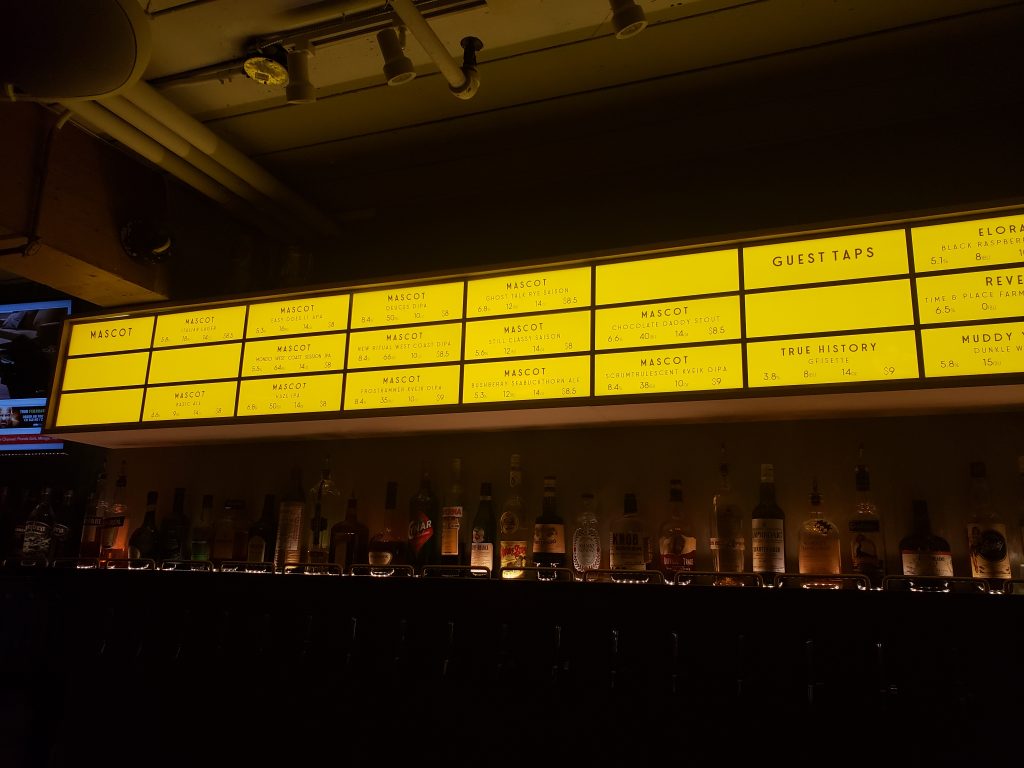
I’m struck eventually by a single detail, and that is that in late February Mascot has four double IPAs on tap. Not just that, but they are all 8.4% alcohol. It can’t be by chance, so this is skylarking on the part of the new brewer. Maybe recipe refinement and maybe just play, but there’s clearly a base version with different ornamentation. There’s little variation in colour, so yeast and hops are the playground.
New Ritual, at 66 IBU is as close as we’re going to get to the traditional West Coast DIPA. Lemon, orange, and some pine, but mostly just spicy sweetness. There’s enough bitterness to balance the aroma. Frosthammer, a Kveik variant with Nelson Sauvin and Galaxy, comes across sharply fruity with Papaya, guava, kiwi, banana, lemon, with fennel and arugula on the back end. The bitterness is surprising given that it is advertised as 35 IBU. There’s a sharp acidic note on the palate, and the profile is complicated by the flavours the kveik strain (Voss based on the lemon?) has added to the mix. That said, one of the more successful kveik ferments I’ve seen in the wild over the last year. Scrumtrulescent, (which I’m trying just days before James Lipton passes) doesn’t manage the balancing act of Frosthammer, and expresses woody coconut poking through a lot of tropical fruit on a bed of pure sugar. It may as well be soda.
Something illustrative happens. From my left, Trevor asks at one point, what makes one of the guest taps an Old Ale. Old Ale does not come up much, and never had much cache in my experience. There’s not really a satisfactory answer from behind the bar on that point, and Trevor speculates for a minute about what it might be. It’s at this point that I realize that I’m not having any luck looking up information on any of the beers on offer. The website offers lunch, brunch, and dinner menus, but no tap list. You can download a product list from the website, but it is dated April 2, which puts it at at least 49 weeks old. In order to discover which hops are in Frosthammer, for example, I had to look at someone else’s Untappd check in. The tasting notes are my own, and I might have been able to intuit the hop varieties, but the majority of the patrons would not.
Ultimately, it seems like a missed opportunity. The beers on offer are, at least stylistically, cutting edge and some of them are quite good. It comes down to the question of whether the brewery taproom space is about beer. I would suggest that, given the evidence, it isn’t. That’s not to say that the beer isn’t good; it’s to say that it’s ill-defined. The vibe is defined. The soundtrack is defined. The experience is defined.
I’ll leave you with their website text and let you see if you can spot the missing word: AT MASCOT, WE ARE AMBASSADORS FOR CRAFT. OUR GOAL IS TO INSPIRE THE WORLD TO SHARE IN OUR PASSION TO ELEVATE THE CRAFT EXPERIENCE.
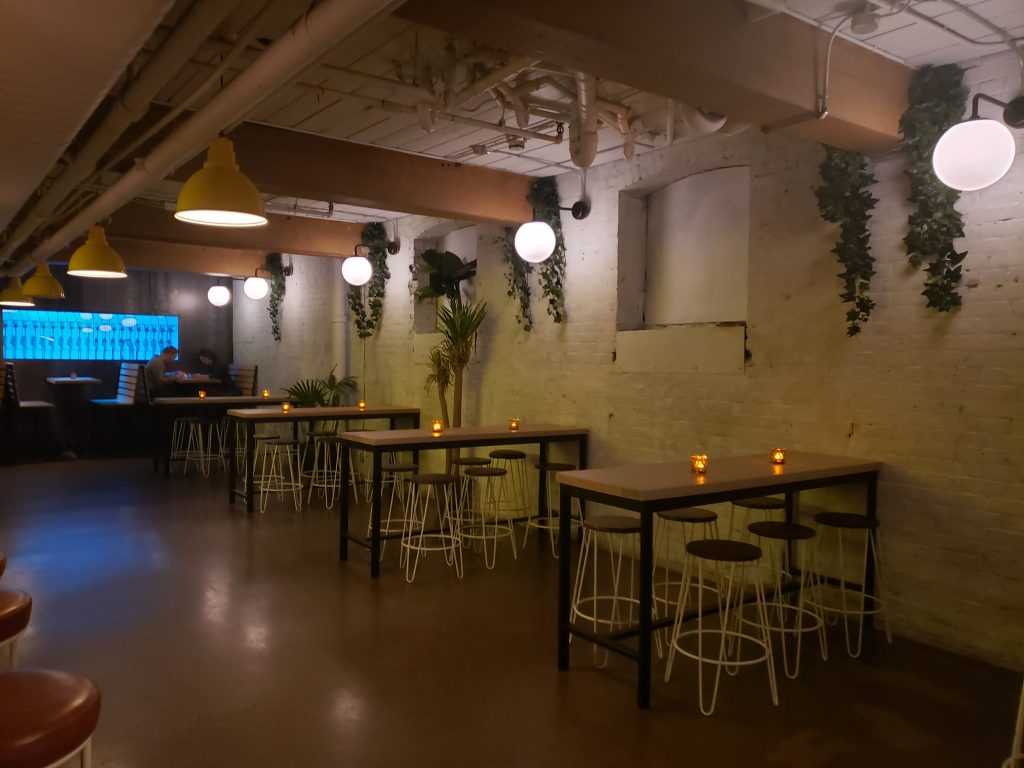
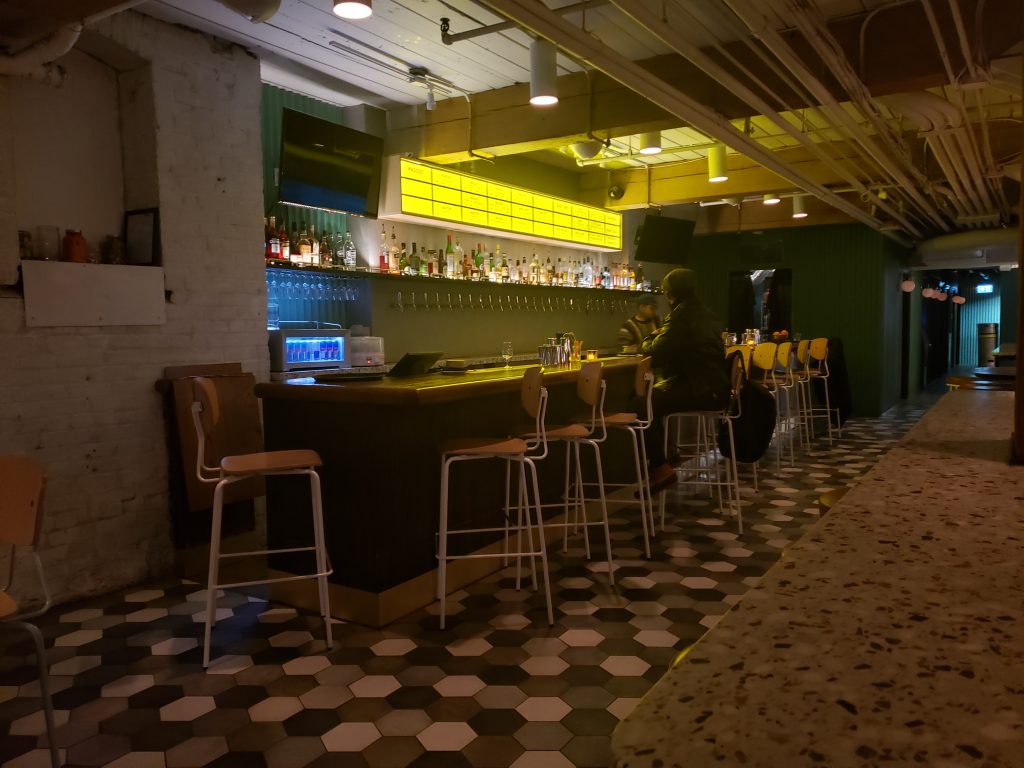
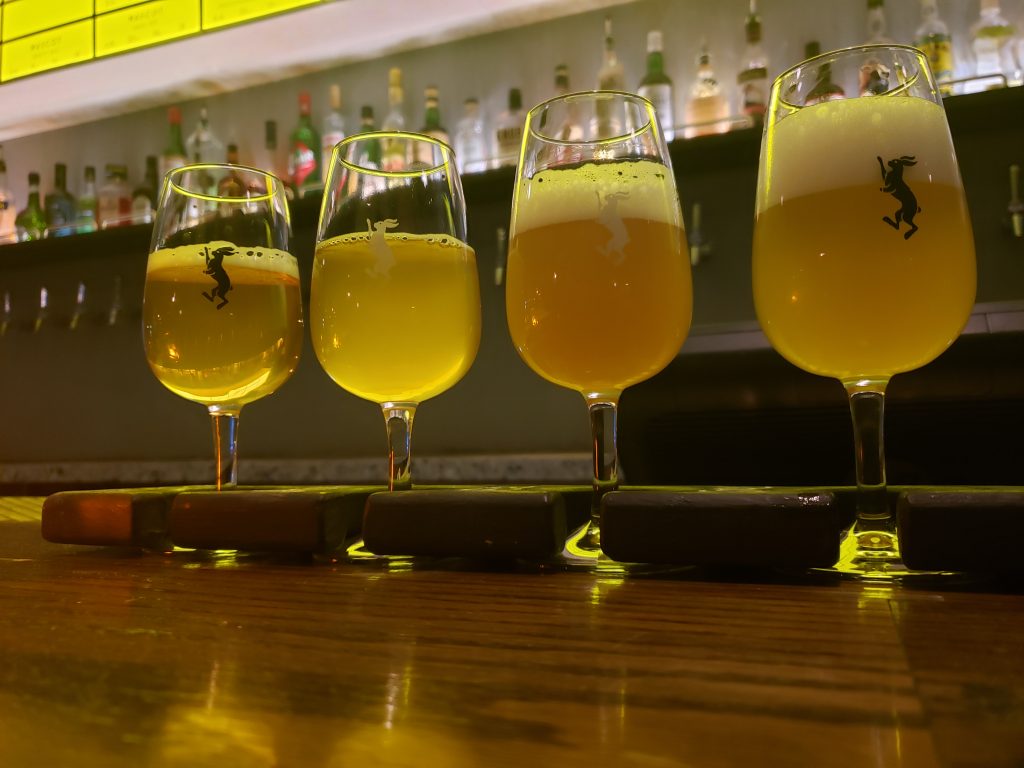
BEER?